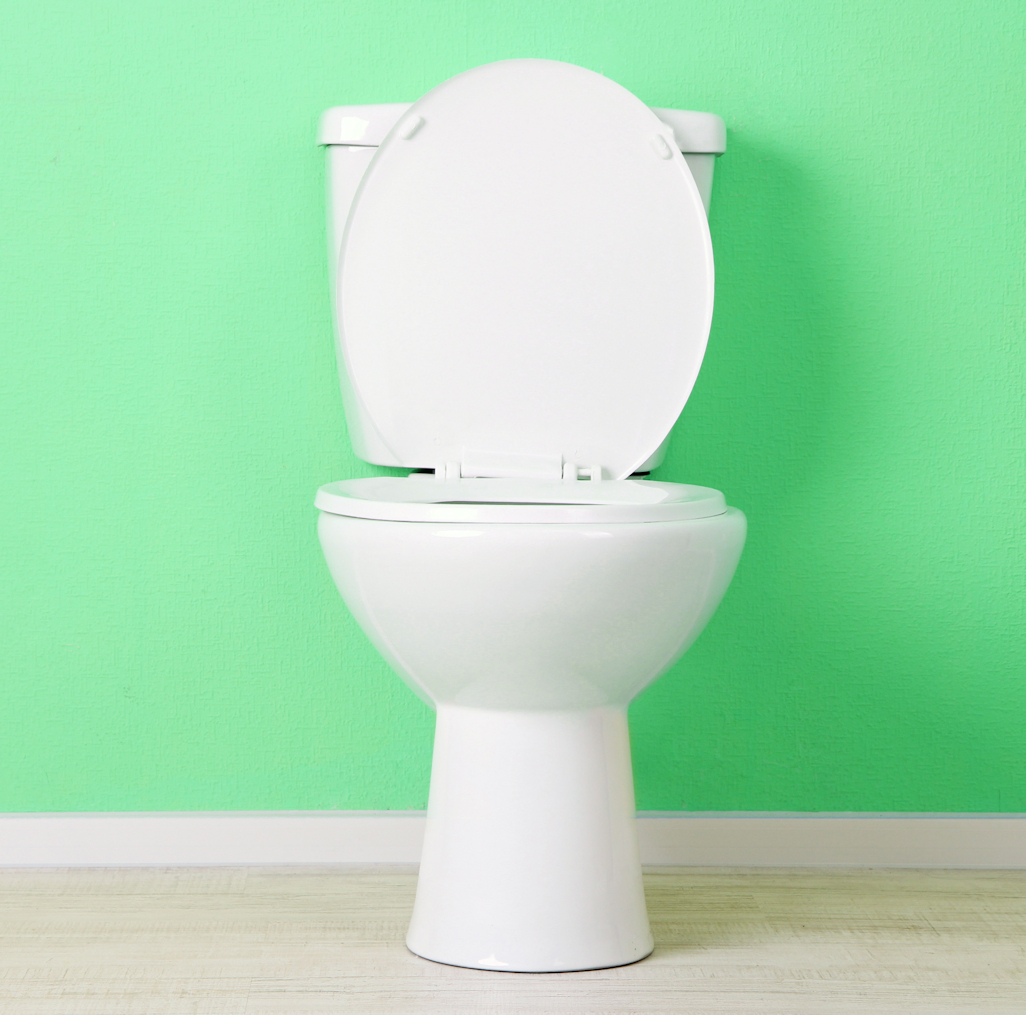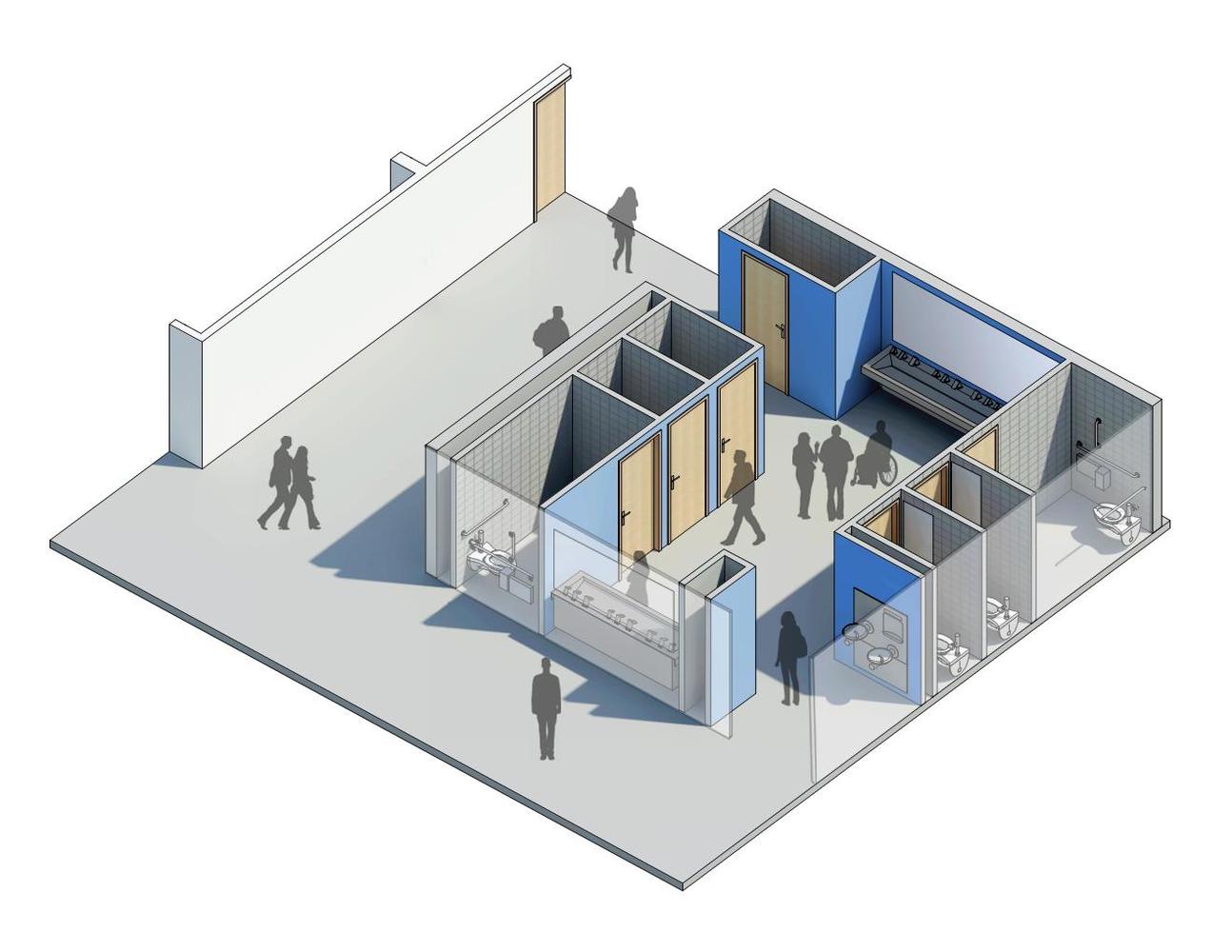When I was traveling in Italy last summer, I noticed that a lot of the restrooms had “stalls” that were more like individual rooms with normal doors. In some cases, the toilets were not reserved for one gender or another – they were just toilets, and the communal sinks were shared by everyone. One big restroom, separate rooms for toilets, one set of sinks – used by anyone who “had to go.” It makes sense if you think about it…I can’t count how many times I’ve stood in line outside of the women’s room while the men’s room was empty.
Last week, one of our specwriters asked me about gender-neutral / gender-inclusive restrooms – common area sinks with full doors into enclosed toilet rooms. He asked whether there was a code change motivating the move to this type of restrooms, and also asked how the hardware on the individual toilet rooms was being addressed. Are privacy sets typical, or locksets, or pulls with deadbolts? Is there a preference for mechanical indicators or indicator lights? Do the doors usually have door closers or spring hinges?
I knew exactly who to ask – YOU. Are you seeing more of these restrooms in your area? If yes, do you know what is driving the change? How do you handle the hardware?
For more information about the use of gender-inclusive restrooms in schools, universities, and other types of facilities, check out this article from Metropolis: Why Architects Must Rethink Restroom Design in Schools.
And if you’re wondering about the signage, here’s an idea from Sam Killermann: Solution for the “Confusing” Gender Neutral Toilet Sign Issue. This would also help avoid embarrassing mistakes in Latin America, where M is for “mujeres” – not for “men.” 🙂
So…WWYD?
Image: Mahlum
UPDATE: Ron Martinez sent me this photo of a shared restroom that he saw in Cleveland while we were at the DHI Conference. Thanks Ron!
You need to login or register to bookmark/favorite this content.








We have had a Code Official that would not allow use to use the Gender Neutral Restrooms in the overall restroom count for the facility. We had to have the code required Men’s and Women’s restrooms before we could include the others. I have not researched it but I do believe the code still requires a specific number of gender specific restrooms as a minimum.
I’ve noticed more and more places with one of each (M & W or for Lori, M & H) changing to anyone restrooms, both having a changing table.
Best signage goes to “We don’t care which one you use” and the other “We still don’t care”
I have a full separated standard just for these lactation rooms and showers for bike commuters. https://www.facilities.upenn.edu/sites/default/files/pdfs/upenn_hardware_standard_087100_-_restrooms_lactation_rooms_showers_0.pdf
Use of inclusive toilet rooms may require a local building code amendment or permission from the building official, depending on how narrowly typical building code text is enforced.
IBC 2902.2 Separate Facilities. Where plumbing fixtures are required, separate facilities shall be provided for each sex.
I had a daycare project where the idea was to share a pair of separate toilet rooms between two adjacent rooms for children. “Jack and Jill”, as the term is used for residential projects – but without gender identification. Plan reviewer didn’t like that, and required that they be gender-identified.
The day care people said “young children don’t care who has been in the room before them”, but Mr. Plan Checker would hear nothing of it. Oh, we could have the non-labeled toilet rooms, but we couldn’t count any of the fixtures toward meeting required counts. I think they will take the signs off when they have passed the final inspection.
Taken to the extreme, “separate facilities” would bar the common school setup with toilet rooms separated from hand washing areas, where hand washing happens at fixtures open to a hallway.
I’ve seen a couple of high schools come through with those style of restroom. These in particular were mortise locks with privacy deadbolt functions and occupancy indicators. Can’t say I’m familiar with any such code requirement in my area, for or against. I think it’s just easier to go that route (still have the family one for the parents with little ones).
I’m not sure Schlage makes a mortise lock with an indicator. (if they don’t, they should) The privacy deadbolt is problematic because students can lock themselves in a bathroom. Our district does not allow thumb-latches for this reason. We install storeroom function mortise locks. You need a key to always enter, and knocking first is common courteous.
Schlage has the L9444 privacy with deadbolt and they have different options you can add for indicators. search for L series mechanical indicator, and you should find the data sheet for them.
you are right though, the thumbturn does cause problems with some school boards.
If a project is being specified with cylindrical locks, I always use mortise privacy sets with an indicator at the unisex restrooms or lactation rooms. That way it’s one motion to egress.
https://americanrestroom.org is a good place to get up to speed on public restroom design.
I have personal reasons for applauding the use of more gender neutral restrooms. Saw them in New Zealand as well as Europe. North Carolina had a hate bill that has since been modified that people had to use the bathroom of the gender that was assigned to them at birth regardless of how they are presenting. Huge problems with that thought. And just in general you get the next available stall (that have individual doors and small sinks and locks) then going into a huge area. Also, I would think cleaning crews only close 1 restroom at a time, rather than closing down the entire male or female restrooms. Codes seem to be state specific but they really need to be changed.
I ran into one of these about ten years ago at MOMA in NYC. It was set up as a row of sinks on one wall, a row of stalls on the other – drywall rooms, partial height partitions, Wood doors with privacy latch sets (as we see in many women’s rooms). There was a separate room for urinals. I loved it because I could supervise my 9 year old son and be available to help my elder FiL without dragging them into the women’s room, These facilities are helpful to more than just “trans” folk.
Have seen more being built in higher tier restaurants in our area. Have seen indicator mortise locks or dummy handles with roller latch and indicator deadbolt.
Personnel opinion is mortise lock with indicator.
This has been approved in Midwest Market for a few years now.
On a college campus that I have done a few buildings on they put in the typical gang restrooms for men and women (as this covers more than 90% of the population), but also requested in several unisex individual restrooms (about 3-4 each on every floor) with privacy function w/ indicator lock sets on them with closers. This is how this campus chose to address this sensitive issue.